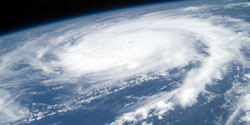 Assessing Projects : Using Assessment to Improve Teaching and Learning
Assessing Projects : Using Assessment to Improve Teaching and Learning Intermediate Phase Assessment Plans | Senior / FET Phase Assessment Plans

Storm Watch
At a Glance
|
Grade Level: 4-6
Subjects: General Science, Maths, Language Topics: Earth Systems, Data Analysis, Writing and Speaking Higher-Order Thinking Skills: Cause and Effect, Analysis Key Learnings: Measurement, Weather Changes, Patterns, Public Speaking Time Needed: 6 weeks, 45 min/day |
Things You Need
Assessing Projects (CD)
Assessing Projects* (online)
People often wonder what causes the different weather conditions they experience. This project helps learners understand the many factors that determine what the weather is like in a particular location, such as the angle of the sun’s light rays, the tilt of the Earth’s axis, and the proximity to water, winds, and elevation. Learners conduct many scientific investigations to understand the complexities of weather systems and to answer Content Questions, such as, What are weather systems, How does air pressure affect our weather, and What causes change in our weather? Throughout the unit, learners are asked to ponder the Essential and Focus Questions, How do people respond to change? and, How does weather affect our lives? In a final presentation, learners take on the role of weather forecasters and report on weather conditions in a city they would like to visit. They demonstrate their understanding about the factors contributing to weather that people throughout the world experience each day.
Curriculum-Framing Questions
- Essential Question
How do people respond to change? - Focus Questions
How does weather affect our lives? - Content Questions
What are the reasons for the seasons?
What are weather systems?
What causes change in our weather?
How does air pressure affect our weather?
Assessment Plan
Assessment Timeline
This timeline shows in chronological order the different types of formal and informal assessments that occur during the project. The table below explains how each assessment is used and who uses it for what purpose.
Assessment Timeline |
Before project work begins |
Learners work on projects and |
After project work is completed |
|
|
|
|
|
|
Assessment |
Process and Purpose for Assessment |
| T-Chart | Learners create a T-Chart to compare and contrast fact from fiction in a story. The teacher uses it as a pre-assessment to determine readiness for studying weather. |
| K-W-L Chart | Learners develop a class K-W-L chart about weather and then create an individual K-W-L in their journals. Learners return to these throughout the project to add additional questions and new learnings. The teacher reviews for understanding and to monitor progress. |
| Science Journal | Learners make observations and keep notes in their science journal as they investigate weather systems. Learners complete specific observations and reflections prompted by the teacher at key times during the project. The teacher reviews during conferences to provide feedback, clarify misunderstandings, and provide additional lessons if necessary. The teacher reviews at the end of the project to assess scientific understanding. |
| Meetings | The teacher schedules conferences to assess the learners’ scientific understanding and the research process and allow for feedback, clarifying misunderstandings, or providing additional lessons if necessary. Pre-planned questions and notes provide documentation for project assessment. |
| Line Graph Rubric | Learners use the rubric to help them complete a line graph with data from their investigations. The teacher uses the rubric to assess their final line graph. |
| Research Checklist | Learners use the checklist to guide them through the research process. Teachers ask learners to bring the checklist to conferences to monitor progress and allow learners to ask questions. Teachers use the checklist to assess learner’s research skills. |
| Multimedia Rubric | Learners use the rubric to ensure they’ve met the expectations as they research a weather system and present their findings. Peers use the rubric to provide feedback to the presenters. |
| Visual Ranking Comments | Learners rank the steps to take in a severe weather system. The teacher probes learner understanding and reasoning through questioning, reviewing comments, and providing feedback. |
| Group Process Rubric | Learners use the rubric to monitor their collaboration skills as they work together in groups on the Visual Ranking activity. The teacher reminds learners to refer to the rubric when there are disagreements or issues about group process skills. |
| Oral Presentation Rubric | Learners use the rubric to guide them through the research and presentation phases of the project. The teacher uses the rubric to assess content integration and oral presentation skills. |
| Reflections | Learners reflect on areas of strength and areas needing improvement after the oral presentation. They also reflect on the Curriculum-aligned Questions throughout the project. The teacher reviews the reflections to analyze learner understanding and to gauge learner’s metacognitive abilities. |
| Test | The teacher uses the test results to assess learner’s science content knowledge. |
Credits
Jeanne Shirley participated in the Intel® Teach Program, which resulted in this idea for an assessment plan. A team of teachers expanded the plan into the example you see here.
